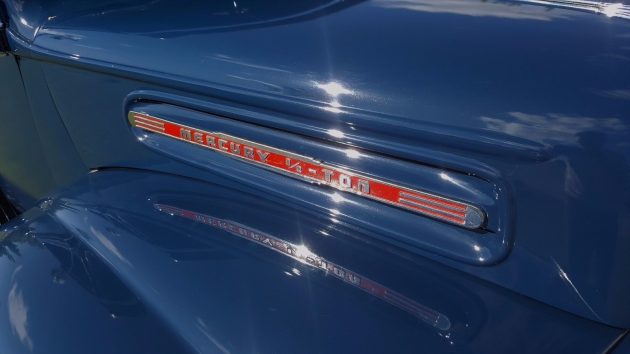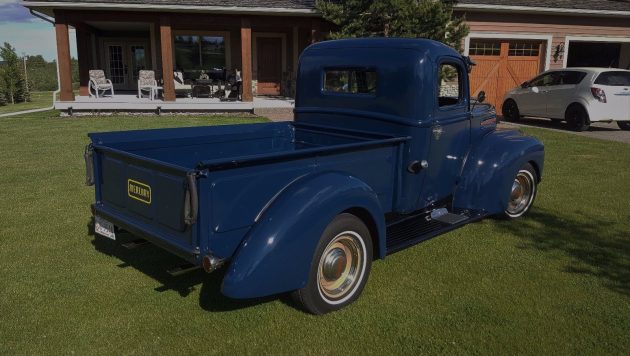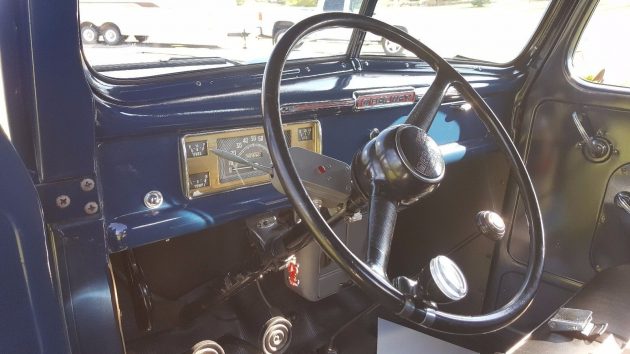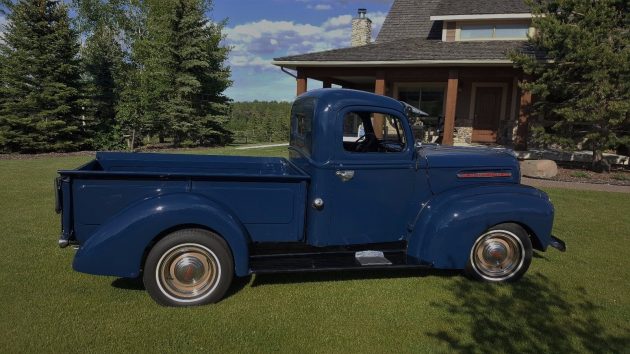Some collectors, especially those who love fifties era collector cars, like to embellish their cars with accessories that were popular in that particular period. Anyone who has ever seen a J.C. Whitney catalog can tell you that there are tons of doo dads and bolt-on items to satisfy any desire. The former owner of this Mercury pickup discovered by the Bison Brothers must have had a weekly subscription to the J.C. Whitney catalog. While a few accessories can be tastefully added, how much is too much? Also, what can this truck teach us about how vehicles are restored? Take a look at this 1947 Mercury half ton pickup currently being auctioned here on eBay. The lucky high bidder will need to pick up the truck in Cavalier, North Dakota.
As our faithful readers know, Mercury pickups were sold exclusively in Canada. Up in the frozen white north, not all Ford Motor Company Dealerships sold Ford trucks. Lincoln-Mercury dealerships were given Mercury branded trucks to sell that were basically Fords trucks with a few extras. These trucks are sought after by American collectors and many are being brought back into the United States by the Bison Brothers. They have amazing luck finding these beauties, and this one is in very nice condition. The truck is stock, except for the addition of a Ford 9″ rear end and an aftermarket radiator. It appears that this truck has been cosmetically restored.
In our hobby, the word restoration is used a lot, and it has a very broad definition. When we actually look at automobiles that are described as restored, there is a big gap between professional show restorations that can win awards at Antique Automobile Club of America or Early Ford V-8 Club national meets and restorations that are done to make a car presentable again. At national meets, a team of judges inspect the vehicle form top to bottom, looking to see if the vehicle has been restored to original condition. They look at the materials used to restore the car, whether the exterior color and interior are appropriate, if the nuts and bolts are the correct type and have the correct finish, and so on. Cars that go through this type of restoration tend to bring more money at sale time and the restoration costs are often very expensive. Restorations to make a car presentable again often are limited to repainting the body, fixing any rust problems, recovering seats and doing what is necessary to bring the interior back to good condition and anything else that the owner feels they can complete in the budget they have set aside.
Each type of restoration has its place, and the ultimate goal of saving a collector car from the scrap heap is realized in both scenarios. However, a potential buyer has to be educated about exactly what type of collector vehicle they are buying. There is no substitute for looking at a car in person, preferably with an expert in that type of car with you. However, you can learn a lot by looking closely at the pictures posted on eBay and Craigslist of a particular vehicle. Take this truck for example. We know it has a Ford 9″ rear end in it, which makes it almost impossible to win a national level show. Furthermore, the accessories would have to come off even if you installed the correct rear end. The wheels and tires would have to go too, as would the dual exhaust.
So, it is not a national show level vehicle. That’s OK. It hasn’t been cut up, or had any major engine and transmission transplants, so it is not a hot rod. I would categorize this truck as a local show and cruise in level vehicle. Here is why. If you look at the pictures above, you can see some orange peel and scratches in the paint. Orange peel is a roughness in the paint that kind of resembles the texture of an orange peel. While professional level paint jobs sometimes have orange peel in the finish, this imperfection is almost always repaired when the finish work is done to the paint (wet sanding, compounding, etc…). Often, orange peel is a sign of a painter who lacks experience in spraying, mixing, and/or applying a finish. A lot of times, home restorations, especially for first time restorers, have paint jobs that have imperfections. It is the nature of the beast, as doing body work, applying primers, paints, and clears, and doing the finish work is difficult, and experts are good at it because they do it every day.
Under the hood, we see other clues. The air cleaner appears to be polished metal with maybe a clear coat finish over it. The factory finish should be black, as it should be for the breather that received the same treatment. The hose clamps and cut off pieces of radiator hose are off the shelf components at the auto parts store, and the chrome acorn nuts holding the Flathead V-8 heads down are also non-stock items. The auxiliary oil filter, which is not stock, is a good add on for earlier engines. It appears that the wiring harness could be original. If the wires are in good condition though, I could live with that. However, I’d regularly check for shorts in the harness to prevent a fire from starting. The biggest clue is the aftermarket radiator. It looks to be a larger than stock radiator with additional cooling capacity.
All told, this is a really good truck to go to local shows in, to have fun driving, and to create memories with your family with. It is a good solid truck, but it is not a show truck. It also isn’t commanding a show truck price.
We all get excited over the cars we read about and see for sale on the internet. With easy financing, affordable shipping options, and auctions that end in short periods of time, it is easy to get in over your head and make a poor decision. However, the internet has opened up research options that would make our predecessors green with envy.
The best way to approach buying a collector vehicle nowadays would be to narrow your list down to just a few vehicles that you would want as a permanent part of your collection, do as much research as possible into every aspect of the vehicle’s history and driving characteristics, look at parts availability, and then make a list of the strengths and weaknesses of your choices. Take some time to research what the vehicles sell for and the condition at the time of these sales. Also, honestly look at your ability, time, space, and tools to determine what level of condition you feel comfortable purchasing a car at. If you have done all of the above, then your odds of being content with the sale and happy with the vehicle are much better.













Good catch! I don’t blame the rebuilder for sticking a Ford removable carrier in there; the old 3-piece is limited to what you can do although I’ve had few problems with mine. Looks like someone also replaced the motor with an 8BA series. Easier to access the distributor although the old dual point unit that was down in front worked very well.
Geomechs…what did the 8A come out of?. Personally while they work well, the crab distributor on my 59AB is a royal pain in the ass! I actually despise it! lol What is this distributor set up that’s on this Merc? Inquiring minds want to know (and already should)
Hi Mountainwoodie. The 8BA/8CM came out in ’49 and were built in various model numbers until ’53 (’54 in Canada). The distributor on that was a vacuum advance only whereas the dist. before that was both centrifugal and vacuum. The old P.I.T.A. distrubutor down front was actually designed by Mallory and worked quite well as long as everything was in working order. They can be worked on right on the bench then installed (only fit one way) and everything should work. Some owners carry a second dist just in case. That old crab dist. cap is a RPITA as it tends to crack and spread those cracks all over the place. They are so fine that you can’t see them. Personally I would upgrade to the newest cap and be done with it; they even work well in a little bit of moisture…
geomechs: thanks for the education. So the 8A was in the shoeboxes. No wonder I know nothing about them. The crab top distributor on my ’47 hasnt given me any trouble in over ……….seventeen years! Still you practically have to dismantle the front end of the car to get to it ( or at least I did ) lol.
Nice write-up. I would add to your last paragraph that a potential buyer should do a personal inspection of the car/truck/bike of have someone inspect the vehicle for them.
I create an inspection list for the particular make and model of any car that I’m considering buying. As you mentioned, you can research areas of concern for any particular vehicle on the internet. But also include general inspection items for any vehicle such as looked down body panels to check for waves, ect. Or driving the car at 40 mph in a safe area and bring the car to a quick halt (quick but don’t lock up the brakes). Any shakes, pulsing pedal, rattling, ect during the test? I could go on and on regarding what you should test but you get the idea. Once you have done a through inspection then the pigs with lipstick become very obvious.
With the wrong wheels, tires, and too many gee-gaws, the truck still looks good. Not so sure about the comment about acorn head nuts being incorrect though. I’ve seen many like that over the years, and perhaps being a Mercury had something to do with it?
They aren’t factory correct, but they were very popular dress up items, sort of like braided hoses today.
A very nice truck. I have a 67 Merc, and a Ford by any other name is the same.
hey im in the frozen great white north it 95 in the shade up here ! think I will get my dog team out and go hunt a polar bear for supper that is if I can get back to my igloo eh!
Soon as I finish my bottle of Crown, I’m frying up some peameal and eggs, then pour the maple syrup all over them!
I am Canadian & don’t think we ever had access to J.C. Whitney Catalogues-Someone please correct me on this if need be.
Yep, I bought stuff from them and had it shipped to Canada. They had some real crap, but they also had a lot of great products that were difficult to find anywhere else. Some examples I remember, are all manner of Jeep parts (running gear and engines), Ford V8 flathead parts including engines, all manner of piston sets, bearings, gaskets. I wish they had the same stuff today.
Come on! We had it way better than JC Whitney. All good car accessories came from Canadian Tire!
There was no Canadian Tire in the West until the 1980s, and their selection of special stuff didn’t come close to matching the Whitney catalog. The closer equivalent would be Princess Auto.
In the sixties my favorite was “Western Auto” , who else remembers.
My ’31 Ford roadster has a Western Auto water pump on it from the 40s. :-D
We had a Western Auto in Connecticut back then too
Orange peel is often a result of enamel which was used by Ford products long after other auto manufacturers switched to laquer.
I have lived the majority of my life in BC, and I never heard of “Western Auto”.